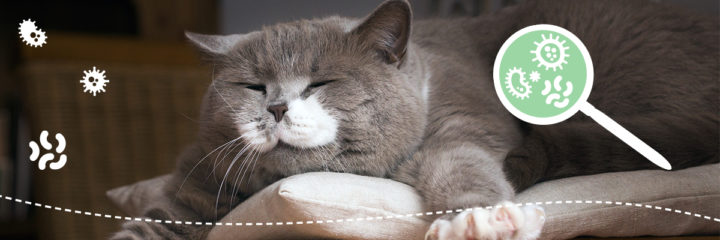
Summary
- A vicious circle exists between chronic kidney disease in cats and dysbiosisImbalance of organisms of the the microbiome (all microbes on or within an animal’s tissues), for instance the imbalance of the intestinal flora as part of the microbiome.... of the microbiomeAll microbes on or within an animal’s tissues, for instance in the intestines (intenstinal flora = the totality of all microorganisms that colonise the intestine). It includes bacteria, protozoa, fungi and viruses....
- Breakdown products such as uraemic toxinsToxic, nitrogen-containing urinary substances responsible for uraemia and kidney damage...., which are toxic to the kidneys and other organs of cats, are produced in the intestines
- Breaking the gut-kidney axis is an important approach to treating chronic kidney disease in cats
*Advertisement, as brand name mentioned
The gut-kidney axis
In the intestines, food components are broken down and made accessible to the body. This produces breakdown products which are eliminated in the faeces as “waste”. Such breakdown is normal. However, there are also breakdown products formed in the intestines that are metabolised in the liver and need to be excreted via the kidneys. These can also be toxic for the kidneys and organs. Such uraemic toxins are produced precursors from microbial protein digestion in the intestines and are part of the gut-kidney axis. Uraemic toxins are usually excreted in the urine. Only when kidney function is impaired do they persist in the body, leading (regardless of their concentration) to kidney and other organ , and contributing to chronic kidney disease progression. Bacteria in the intestines therefore affect the progression of chronic kidney disease by producing precursors of these uraemic toxins.
The friendly companions of the microbiome
The term microbiome refers to all microbes on or within an animal’s tissues, for instance in the intestines. There are billions of them in the gastrointestinal tract and especially in the colon. The microbiome has a profound influence on metabolic processes, but has not yet been fully researched. These bacteria constitute an equilibrium, their numbers are balanced, and they form an ecosystem both amongst themselves and with their host. Interactions take place between the host and its microbiome. For instance, intestinal bacteria contribute not only to the host’s metabolism in digestion but also to its immune system. If the composition of intestinal bacteria is imbalanced (dysbiosis), this can potentially lead to a variety of disorders in the host.
These include inflammatory changes as well as disorders at sites beyond the intestines, as is the case in chronic kidney disease. The state of well-being of an animal is also linked to the microbiome, which is, amongst other things, believed to be associated with allergies, arthritic diseases, diabetes and thyroid disorders. A dysbiosis changes the delicate balance between the bacteria. The ecosystem of the intestines comprises bacteria that are dependent on each other. That’s why prebiotic supplements that only support a single or a small number of bacterial species in the intestines are often only minimally effective. The microbial community to be supported or replaced in disease. One interesting treatment approach relating to the microbiome is stool transplantation. This was authorised in 2013 by the American Food and Drug Administration (FDA), the American regulatory authority for pharmaceuticals, in the form of capsules containing frozen stool from appropriate donors.
Attack on the microbiome
In chronic kidney , indoxyl sulphate, the principal uraemic toxin, causes bacteria that specifically form uraemic toxin precursors to multiply. Indoxyl sulphate itself is generated by microbial protein breakdown in the intestines and is converted to the true toxin in the liver. Chronic kidney disease prevents it from being excreted, increasing its level in the blood and contributing to further problems. sulphate causes the bacteria of the microbiome to produce even more uraemic toxins, in particular indoxyl sulphate and para-cresyl sulphate, which cannot be excreted via the kidneys and are therefore harmful to the body. In addition, indoxyl sulphate also renders the intestinal barriers more permeable. As a result, further harmful substances (known as “enterotoxins”) gain entrance into the body and stimulate inflammatory processes. This creates a “predisposition” for inflammation in chronic kidney disease. This predisposition can also contribute to chronic kidney disease progression. Indoxyl sulphate and also para-cresyl sulphate (another uraemic toxin associated with the gut-kidney axis generated by microbial protein breakdown in the intestines) can cause insulin resistance (diabetes), activate the renin-angiotensin-aldosterone system (RAAS) and thus contribute to high blood pressure, increase phosphate levels, trigger anaemia and contribute to life-threatening changes in the cardiovascular system and chronic kidney disease progression via inflammatory changes in the kidneys. In human medicine, both uraemic toxins are causally correlated with mortality in patients with kidney disease. They have also been demonstrated to influence outcomes in cats with kidney disease.
Breaking the gut-kidney axis
Breaking the gut-kidney axis is, therefore, an important approach to treating chronic kidney disease in cats. Prebiotic supplements are often only minimally effective in achieving this, and mostly only have a short-term effect. In human medicine, an approach has therefore been developed to prevent uraemic toxin precursors from passing into the blood. This involves binding the precursors of the uraemic toxins in the intestines via a carbon adsorber and consequently expelling them via the faeces. This stops the production of uraemic toxins. Multiple studies have demonstrated that this new approach is successful in lowering indoxyl sulphate blood levels, improving the symptoms of chronic kidney disease patients and prolonging survival.
Black-balling the toxins – carbon as a specialised uraemic toxin binder
The approach does not involve medicinal activated charcoal. Rather, the substance in question is composed of spherical carbon particles prepared in a patented process. These can pass through the intestines unchanged and do not cause the stool to turn black, as they do not dissolve in the gastrointestinal tract. These tiny carbon spheres not only have a special shape that prevents the gastrointestinal tract from being injured, their surface is also covered in numerous pores that allow uraemic toxin precursors to penetrate their interior. Medicinal activated charcoal also derives its effect by adsorbing toxins. Carbon has a natural capacity to bind toxins. Activated charcoal, however, is problematic, in particular due to the shape of its particles and its lack of selectivity. Activated charcoal particles have a rough, edgy particle makes it prone to forming clumps and to irritation of the gastrointestinal mucosa, causing constipation, abdominal pain, vomiting and diarrhoea. Carbon particles that are spherical do not have these disadvantages, as has been demonstrated in clinical studies.
“Cherry-picked” adsorption
Selectivity is crucial in the approach; only those substances that need to be removed from the intestines are adsorbed into the carbon spheres. If, for instance, the particles adsorbed nutrients such as fats, vitamins or digestive enzymes, long-term use would result in nutritional deficits. This is what happens with activated charcoal. That’s one of the reasons why activated charcoal should only be employed in the short term. Selectivity is related to the size of the pores. Uraemic toxin precursors are very small, so that vitamins, for example, cannot follow them into the interior of the particles. In addition, uraemic toxin precursors are charged, and the interior of the particles has an opposite charge, physically binding the precursors within the particles. The pores of medicinal charcoal particles are larger, meaning that they can also adsorb other substances, even medicines. The patented process used to manufacture the novel carbon adsorber, in contrast, produces pores of a specific size to prevent this from happening. The same “uraemic toxin binder” spherical carbon approach has now been applied to cats, likewise with increased selectivity to ensure that only substances that are harmful to the cat are bound. Indole and p-cresol as precursors of uraemic toxins. In the case of cats these carbon spheres are marketed under the name Renaltec®, and are derived from coconut shells. They are effectively a form of “oral dialysis” for cats. Studies in geriatric cats have demonstrated that they can “break through” the gut-kidney axis.
*As this article contains named active substances, I am marking this article as an advertisement
Bibliography:
- Evenepoel, P. (2016). Darm-Nieren-Achse-Einfluss der Darmmikrobiota auf die Progression einer chronischen Nierenerkrankung [The influence of the intestine-kidney axis of the intestinal microbiota on the progression of chronic kidney disease]. Der Nephrologe, 11(4), 275–281.
- Yong, E. (2018). Winzige Gefährten – wie Mikroben uns eine umfassendere Ansicht vom Leben vermitteln [Tiny companions – how microbes give us a more comprehensive view of life]. Munich: Anje Kunstmann
- Welsch, B. (2019). Die Bedeutung des Urämietoxins Indoxylsulfat für den Verlauf chronischer Nierenerkrankungen [The importance of the uraemic toxin indoxyl sulphate in chronic kidney disease progression]. Kleintiermedizin, 22(1), 34–40.


